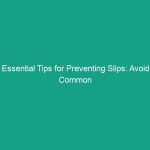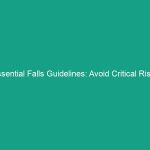Good Morning Team!
Today, we’re going to discuss a critical aspect of Workplace Safety: Essential Trips Guidelines: Avoid These Common Workplace Hazards. Understanding how to prevent trips and falls is vital for ensuring a safe working Environment. It’s not just about compliance; it’s about protecting ourselves and our colleagues from unnecessary injuries.
Understanding Essential Trips Guidelines
The term Essential Trips Guidelines refers to the Procedures and practices designed to mitigate the risk of trips and falls in the workplace. These accidents can happen in any setting and can lead to serious injuries, making it crucial for all employees to be aware of the Hazards and how to avoid them.
Many employees might think that trips and falls are minor incidents, but the reality is that they can lead to severe injuries, lost workdays, and even long-term disabilities. In fact, according to the National Safety Council, falls are one of the leading causes of workplace injuries.
Key Hazards, Risks, and Safety Considerations
Let’s explore some common hazards that contribute to trips and falls:
- Cluttered Walkways: Items left in hallways, walkways, or work areas can create tripping hazards.
- Uneven Surfaces: Cracks in flooring, raised thresholds, or uneven outdoor surfaces can lead to accidents.
- Inadequate Lighting: Poorly lit areas make it difficult to see potential hazards.
- Wet or Slippery Floors: Spills, rain, or cleaning can create slippery surfaces.
- Improper Footwear: Wearing inappropriate shoes can increase the risk of slipping or tripping.
Ignoring these hazards can lead to serious consequences. Just last month, an employee tripped over a loose cable and fractured their wrist. This incident not only caused pain and suffering for the employee but also disrupted workflow and affected the entire team.
Best Practices, Procedures, & Actionable Advice
To prevent trips and falls, we should follow these Best Practices:
1. Keep Work Areas Clean and Organized
Ensure that all walkways and work areas are free from clutter. Make it a habit to put away tools and materials after use.
2. Report Hazards Immediately
If you notice a hazard, such as a wet floor or a loose tile, report it to your supervisor right away. Prompt reporting can prevent accidents before they happen.
3. Use Proper Lighting
Ensure all areas are well-lit. If you notice a burned-out light bulb, replace it or report it for replacement.
4. Wear Appropriate Footwear
Choose shoes that provide good traction and support. Avoid wearing flip-flops or shoes with slick soles.
5. Be Aware of Your Surroundings
Stay alert and aware of where you’re walking. Avoid distractions like your phone when navigating through the workplace.
Regulations, Standards, and Compliance
Compliance with Safety Regulations is crucial for maintaining a safe workplace. The Occupational Safety and Health Administration (OSHA) has established Standards that require employers to provide a safe environment, which includes addressing trip hazards. Familiarizing yourself with these regulations not only helps protect you but also your colleagues.
Employee Engagement & Discussion
Now that we’ve discussed these guidelines, let’s open the floor for some discussion. Here are a few questions to consider:
- What safety challenges have you encountered related to trips or falls?
- Can you share an experience where following Safety Guidelines helped prevent an accident?
- What additional measures do you think we could implement to improve safety in our workspace?
Feel free to share your thoughts — your input is valuable in creating a safer workplace!
Conclusion & Key Takeaways
In summary, understanding and applying the Essential Trips Guidelines is crucial for preventing workplace hazards. Remember:
- Keep work areas organized and free of clutter.
- Report hazards immediately.
- Ensure proper lighting and wear appropriate footwear.
- Stay aware of your surroundings at all times.
By prioritizing these safety practices, we can create a safer work environment for everyone. Thank you for your attention and your commitment to safety. Let’s work together to ensure that each day is accident-free!


